When I signed up for the project in Cambodia, I had no idea that it would leave me with so many experiences and emotions that it would be difficult for me to process it all. Right now, if anyone asks me how was my experience in Cambodia, I find myself at loss for words. Recently I gave a presentation to my team about my trip and had about an hour to talk about my stay in Cambodia. Once the presentation was over, I realized I had missed many things that I wanted to share. So I decided that writing a blog about it would be a good idea. Pictures in this blog are the slides that I used during the said presentation.
Adobe, with the help of Team4Tech, runs CSR projects in various countries. For each such project, a team of volunteers from Adobe, accompanied by a Project Director from Team4Tech, head to the selected country and work with an NGO to deliver various training and workshops. In Cambodia, Adobe works with Care Cambodia, an organization that is dedicated to uplifting women and improving the state of education. For our project, we had to deliver workshops on the following topics:
1) Leadership Development (For Care Cambodia Staff)
2) Information and Communications Technology (ICT) (For Care Cambodia Staff and Core Trainers)
3) Monitoring and Evaluation (M&E) (For Care Cambodia Staff)
4) Publishing a Digital Magazine (For School Students)
In the image above, you can see the drawings made by the kids participating in the digital magazine workshop. We had asked them to draw their dreams.
Above are some snapshots from the activities we did during the various workshops. Participating in this project meant 6 weeks of preparation before the project started and then 12 days of in-country work. During the pre-project stage, we had two meetings every week and apart from that there were readings to be done and lesson plans to be prepared. It meant about 6-7 hours every week in the beginning, but later it got busier as we started working on our lesson plans. Because of so many unknowns (we did not know the kind of facilities we would have in-country or the skill level of the participants) we had to have plan B at many places.
Astha, Danielle, and Ty delivered the Leadership Development and ICT workshops, whereas Nidhi and I delivered M&E and Digital Magazine Workshops. In this blog, I will talk more about M&E and Digital Magazine workshops.
Owing to my background in literature and my experience of running a digital literary journal, I was a little more confident of delivering the Digital Magazine Workshop than the M&E one. Moreover, I was worried that I would be teaching M&E to people who probably know it better than me. Before the project started, M&E was a concept I had only heard of. Even though as software engineers, we instinctively do M&E, the exact terminologies and formats, when M&E is used by NGOs, were new to us. This fact scared me immensely.
Martin, our project manager for the Cambodia project, encouraged us throughout and Nidhi and I worked as a team and after some sleepless nights were able to design lesson plans for both Digital Magazine and M&E workshops. Despite having developed the lesson plan, our confidence in M&E remained low.
However the situation turned around completely in Cambodia. We discovered that in case of M&E, the fact that some members of the audience knew the subject actually helped us. We were able to integrate their expertise too into our curriculum and were able to relax knowing that after we leave the country, the team will have people who will be able to guide them in using M&E in their day-to-day lives.
Above are some snapshots from the activities we did during the various workshops. Participating in this project meant 6 weeks of preparation before the project started and then 12 days of in-country work. During the pre-project stage, we had two meetings every week and apart from that there were readings to be done and lesson plans to be prepared. It meant about 6-7 hours every week in the beginning, but later it got busier as we started working on our lesson plans. Because of so many unknowns (we did not know the kind of facilities we would have in-country or the skill level of the participants) we had to have plan B at many places.
The
schedule in-country was hectic. We used to wake up at 5, have our
breakfast at 6:30 and begin our workshops at 7:30 or 8:00. We used to
work until 5:30 and head for dinner at 6:30. Before dinner we used to
have our evening reflections, during which we used to go through our day
and analyze what went well, what were the challenges, what were the
learnings etc. After dinner, we would work on our next day's lesson
plans and then go to bed. Lesson plans had to be reworked a lot and we
had to think on our toes in order to make our workshops most effective.
Because of the difference in the realities between the countries we were
coming from and Cambodia, many of our assumptions had to be
re-adjusted.
Astha, Danielle, and Ty delivered the Leadership Development and ICT workshops, whereas Nidhi and I delivered M&E and Digital Magazine Workshops. In this blog, I will talk more about M&E and Digital Magazine workshops.
Owing to my background in literature and my experience of running a digital literary journal, I was a little more confident of delivering the Digital Magazine Workshop than the M&E one. Moreover, I was worried that I would be teaching M&E to people who probably know it better than me. Before the project started, M&E was a concept I had only heard of. Even though as software engineers, we instinctively do M&E, the exact terminologies and formats, when M&E is used by NGOs, were new to us. This fact scared me immensely.
Martin, our project manager for the Cambodia project, encouraged us throughout and Nidhi and I worked as a team and after some sleepless nights were able to design lesson plans for both Digital Magazine and M&E workshops. Despite having developed the lesson plan, our confidence in M&E remained low.
However the situation turned around completely in Cambodia. We discovered that in case of M&E, the fact that some members of the audience knew the subject actually helped us. We were able to integrate their expertise too into our curriculum and were able to relax knowing that after we leave the country, the team will have people who will be able to guide them in using M&E in their day-to-day lives.
In case of Digital Magazine, on the other hand, we faced a couple of unforeseen challenges. The application that we had finalized before we landed in Cambodia turned out to be not supported on the Tablet that the kids had. We received these tablets for setting up only a couple of days before the workshop started so we had to quickly find another application that could be used and redesign our lesson plans according to it.
Another challenge we faced in Digital Magazine workshop was because of our assumption of the pattern of schooling the children would be having, and the kind of exposure they would have to magazines. We found that the only magazines the kids were familiar with were academic or technical magazines published by Care. It was very challenging for us to make them imagine the possible contents of a digital magazine. We had to quickly rethink our approach and incorporate more samples and examples. Technology, on the other hand, wasn't a challenge at all with the kids. We also did not realize that the kids aren't really used to presenting their work to their peers and teachers. However, when they were asked to do it, they did it well after some hesitation. Below is the video of a child presenting his work to the audience.
Apart from the academic activities, we planned several ice-beakers and break activities. We made children and adults play games such as musical chair. We also made children dance to Bollywood music, if they were even a little late for the workshops. Everyone participated in and enjoyed these activities to the fullest. Nidhi was our ice-breaker champion.
Here is the team. The first photograph on top-left features our project director, Martin. The dog sitting next to him was our constant companion during breakfasts and dinners. We used to go to Cafe Alee for breakfast and dinner and to Green Carrot for lunch. These cafes were the only two restaurants apart from our hotel that we were allowed to eat in. Team4Tech and Care Cambodia were very careful with our safety and health.
In the photograph on the bottom-left, you can see our entire team. (From Left to Right: Ty, Nidhi, Astha, me, Danielle, and Martin). This was our last breakfast at Cafe Alee, once we were done with the project. After this we headed back to Phnom Penh.
The photograph on the bottom-right is clicked with the students who participated in the Digital Magazine workshop. The person clicking the groupie is our translator Nhoeb Khan, who is also the M&E lead at Care Cambodia. He very patiently stood by our side day after day for 10 days and translated every sentence we said from English to Khmer. The lady clicking the selfie (standing with the school kids) is Rathana, who also helped us a lot in running the Digital Magazine workshop.
In case you need more information on any workshop in particular, feel free to leave a comment and I will make sure that I respond. In the meanwhile, here is a video of our Project Director practicing the Indian head nod.
Next, we will talk about some aspects of Cambodia. The fact is when you first land in Cambodia, if you are an Indian, you will likely not feel that you are in a foreign country. The vegetation is the same as South India, the people are similar. Only when you start noticing the details, you realize how different things actually are.
There are a lot of monks all around Cambodia. Our research showed that monks aren't supposed to eat or drink anything that wasn't given to them in alms. In remote places, we did see some monks asking for alms from businesses. However, in the cities, we saw many monks using iPhones, DSLRs, having a smoke, drinking beer etc. I have never really been able to get my head around how these things work.
The image at the top-center of collage above was shot in the Central Market, Phnom Penh. Hammock is a favorite with Cambodians. You can see them hanging beneath the stilt houses, inside the tuk-tuks, along the roads, at tourist places, basically everywhere. Many people in Cambodia use hammocks to catch a rest during the day.
The image towards the top-right corner in the above collage is the first image I clicked in Cambodia. I was trying to click the kiosk from where I got my Cambodian Sim so that I could get it recharged if need be, and this man manning the kiosk obliged me with this nice pose and fantastic smile.
While we were on project, we were only eating at places approved by Care Cambodia and Team4Tech. These included the restaurants at Frangipani Living Arts Hotel and Spa and Brooklyn Pizza & Bistro at Phnom Penh, and Cafe Alee and Green Carrots at Banlung. Most of these places offered some good Cambodian dishes, such as the Lok-Lak and Amok, along with good western option. I had one of the best pancakes of my life at Cafe Alee.
Street food in Cambodia is interesting. You will often come across hawkers selling grilled snakes, fried tarantulas, roasted crickets, and whole fried frogs on the roadside. You will also come across some amazing tropical fruits being sold on the roadside. I chose to sample the latter and wasn't disappointed. Fruits in Cambodia are amazingly flavourful and refreshing. In case you want to try bugs and other creepy crawlies, you can try the Bugs Cafe in Siem Reap. There, you will probably not be instantly put off by the plating.
Purely vegan options (as seen in the photograph at the top-right corner of the above collage) are also available in the cities. The food is unusual but tasty. Mango shakes and Coconut juice can be had with all the meals and at most places these are amazingly good.
Streets in the cities are lively with cheerful tuk-tuk drivers, decorative fairy lighting, fountains, interesting buildings, and people playing jianzi. At one point we saw some policemen too join in a game of jianzi being played by 7-8 people at Phnom Penh Riverside. They were miserable at it.
You will see heavy traffic especially in cities such as Phnom Penh. Vehicles are left-hand drive in Cambodia. However, if you are from a country that has Right-Hand Drive and often find yourself jumping into the traffic while watching out for traffic on the wrong side, don't worry. Your life will probably be spared, because Cambodian drivers tend to stop to give way to Jaywalkers as well along with well-behaved pedestrians.
Art in various forms is visible at every nook and corner of Cambodia. Be it the musicians performing live in the pub street of Siem Reap or the singers stepping up to sing at the night market of Phnom Penh, or the painters making vibrant strokes that quietly transform into masterpieces in full public view, one can see how artistic Cambodians are.
This talent runs in their genes apparently. If we look at centuries-old Angkor Wat or the 100 year old Ramayana (Ramakerti) frescos in the Royal Palace, we do not need any other proof. And what makes it even better is that Cambodians also demonstrate a sense of humour. Look at the sketch on the bottom-right in the above collage - I found this in one of the cafes and it depicts Ram and Hanuman having coffee over conversation. The sign for the rest room in the bottom-left side of the collage is unique too.
In Cambodia, I spent 10 nights in Banlung, 7 in Phnom Penh, and 3 in Siem Reap. And I haven't had enough of any of these cities. I wish I had a month more to explore the country. If only I wouldn't get so homesick every few days... Anyways, Phnom Penh both shocked and amazed me. The Genocide museum and the Killing fields were a sobering experience. Look them up and you will find out why. The riverside is amazing.
Apart from walking along the quay, you can also observe several amazing customs on display. This practice of setting birds free after praying, for example. Though I find myself cringing at this. The birds that are released are almost immediately caught again and put into crowded cages till someone offers money to set them free. The cycle continues. The birds continue to be caught and released again, and again, and again. What a miserable life!
Apart from this, I absolutely loved Phnom Penh. It is a pedestrian friendly city and you can cover a huge area on foot. It has a good cafe and pub scene and you can even find some good Indian restaurants on the riverside. I ate at the Mother India restaurant quite often and was amazed at the quality of food.
Siem Reap is a great place to spend a week in. You can simply roam the streets, enjoying the pub street, the happening and huge night market. You can shop for clothes and souvenirs till you run out of money. You can try ice-cream rolls. You can walk along the tiny river or admire the beautiful fairy lights. If you have time, you can organize a trip to the floating village or the Angkor Wat. Actually even a week isn't enough to explore Siem Reap, although in size the city is much smaller than Phnom Penh.
If you are going to Cambodia, my assumption is that you will be visiting Angkor Wat complex of temples. Because of course you must. We did a one-day tour to Angkor Wat and covered Ta Prohm, Bayon, and Angkor Wat. Unless you are really interested in temples and architecture, this much should be enough for you. However if you want to explore more, you can purchase a 3 day or a 7 day pass to Angkor Wat Complex.
Ta Prohm is where you will see a miracle. You will see signs of devastation all along. Rocks that once were a part of the massive temple structure lie strewn around. At first we thought that this destruction was caused by Khmer Rouge and were really angry. However, later we found out that the destruction was because of nature taking control. Immediately, our anger vanished, because how can you be angry with nature. Another thing to note is that Ta Prohm is right now being restored, and Cambodian Government is working with the Indian Government to get this done.
Banlung was really the quietest city of them all. Not much of a tourist place, Banlung still sees many foreign visitors mostly on their CSR journeys. But as a result, you can find a good variety of food here. The Yeak Laom Lake is one of the most popular tourist spots near Banlung.
Believe me or not, this was just a gist of my Cambodian Trip. I will keep on talking about this country for quite some time, so please do bear with me. :)
Related Blogposts -












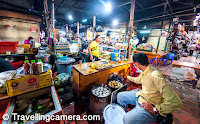


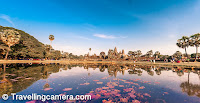
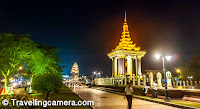
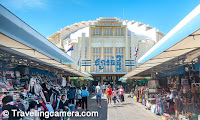

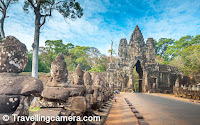
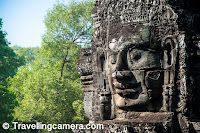

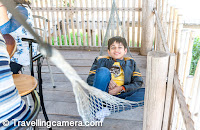




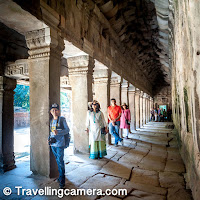

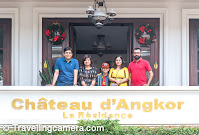


.jpg)
Comments